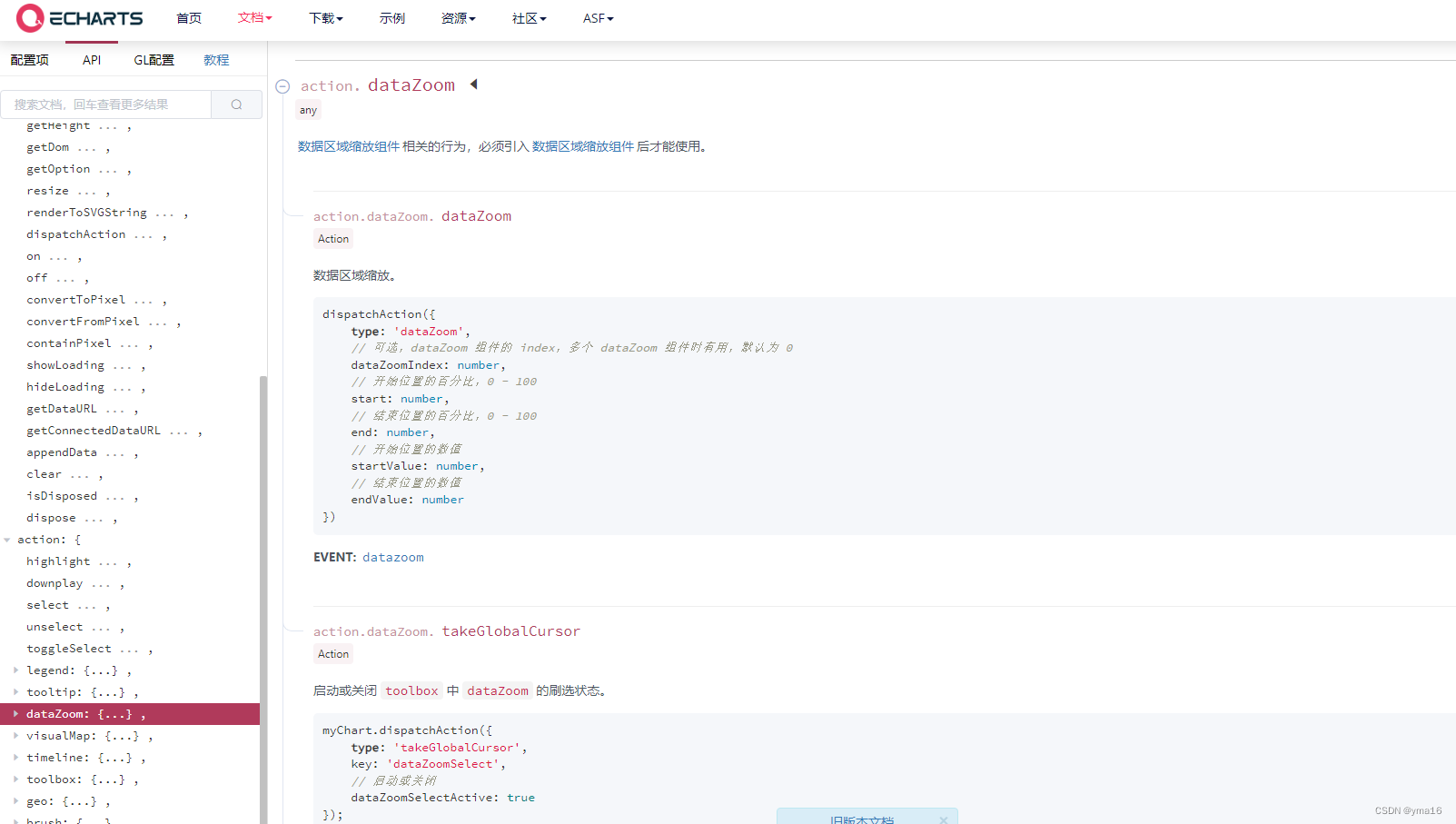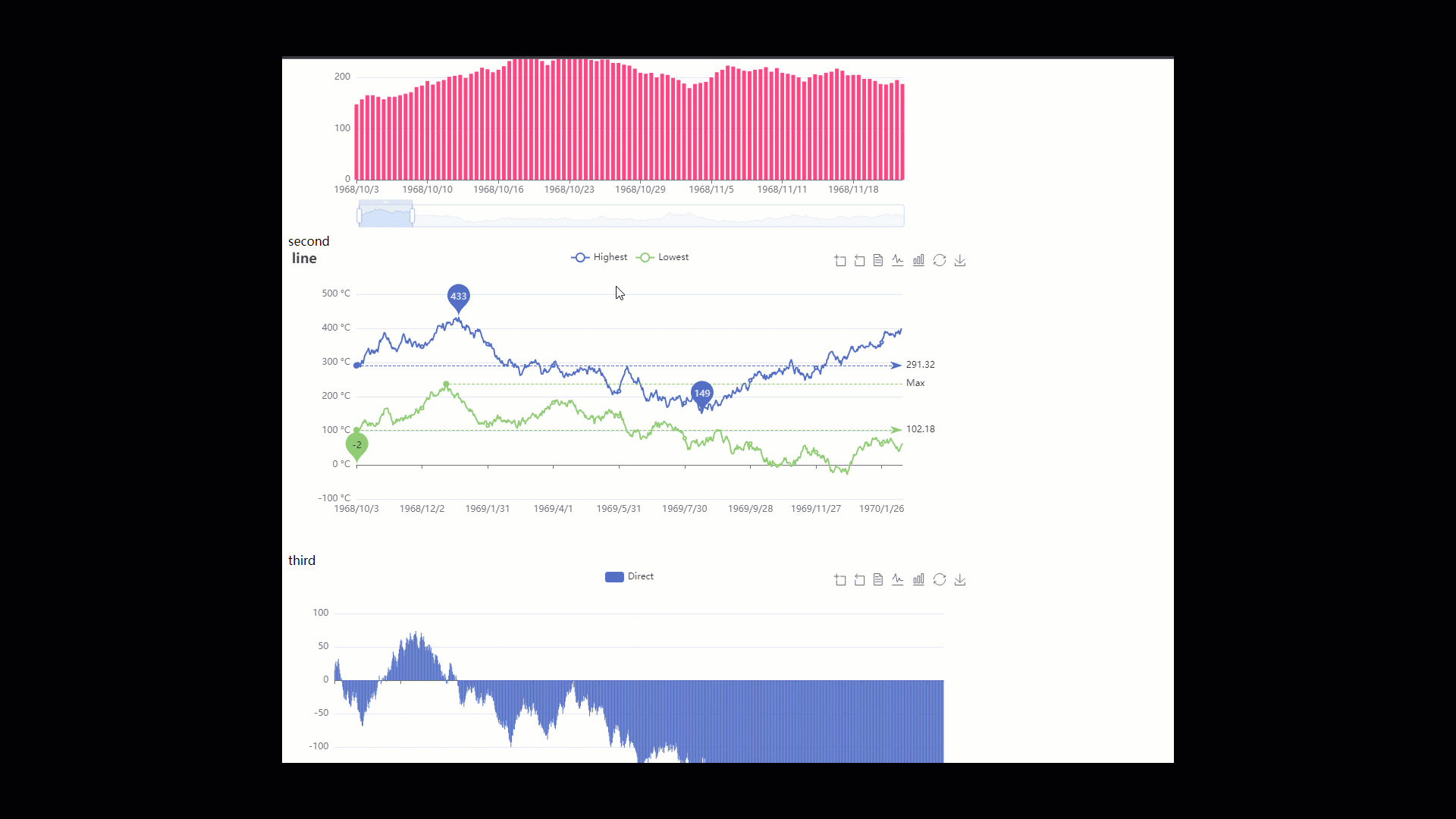⭐前言
大家好!我是yma16,本文分享在vue2和vue3中配置echarts的多图表同步缩放
背景:
解决echarts的多图表x轴同步联动的问题
⭐使用dataZoom api实现echart的同步缩放
echarts的datazoom api对外暴露
原理:
echarts的实例存在datazoom缩放的方法,
所以只需要在datazoom事件触发其他图表的datazoom即可实现同步缩放
dispatchAction({ type: 'dataZoom', // 可选,dataZoom 组件的 index,多个 dataZoom 组件时有用,默认为 0 dataZoomIndex: number, // 开始位置的百分比,0 - 100 start: number, // 结束位置的百分比,0 - 100 end: number, // 开始位置的数值 startValue: number, // 结束位置的数值 endValue: number })
注意:
x轴的范围要一致,不然可能会出现偏移
💖 vue2实现echarts多图表同步缩放
用变量记录echarts的实例,渲染完毕再触发datazoom
<!DOCTYPE html> <html> <head> <meta charset="utf-8"> <title>echarts 滚动事件</title> <!-- vue2 生产环境版本,优化了尺寸和速度 --> <script src="https://cdn.jsdelivr.net/npm/vue@2"></script> <script src="./echarts.js"></script> </head> <style> #app { position: absolute; height: 100vh; width: 100vw; } </style> <body> <div id="app"> <div> first <div id="first" style="width: 900px;height:400px;"></div> second <div id="second" style="width: 900px;height:400px;"></div> third <div id="third" style="width: 900px;height:400px;"></div> </div> </div> <script type="text/javascript"> const instanceVue = { el: '#app', name: 'ecahrts', data() { return { firstChart: null, secondChart: null, thirdChart: null, maxNum:1000, }; }, mounted() { this.initSecondData() this.initThirdData() this.initFirstData() }, methods: { initFirstData() { // 基于准备好的dom,初始化echarts实例 var myChart = echarts.init(document.getElementById('first')); // 指定图表的配置项和数据 let base = +new Date(1968, 9, 3); let oneDay = 24 * 3600 * 500; let date = []; let data = [Math.random() * 300]; for (let i = 1; i < this.maxNum; i++) { var now = new Date((base += oneDay)); date.push([now.getFullYear(), now.getMonth() + 1, now.getDate()].join('/')); data.push(Math.round((Math.random() - 0.5) * 20 + data[i - 1])); } const option = { tooltip: { trigger: 'axis', position: function(pt) { return [pt[0], '10%']; } }, title: { left: 'center', text: 'Large Area Chart' }, toolbox: { feature: { dataZoom: { yAxisIndex: 'none' }, restore: {}, saveAsImage: {} } }, xAxis: { type: 'category', boundaryGap: false, data: date }, yAxis: { type: 'value', boundaryGap: [0, '100%'] }, dataZoom: [{ type: 'inside', start: 0, end: 10 }, { start: 0, end: 10 } ], series: [{ name: 'Fake Data', type: 'bar', symbol: 'none', sampling: 'lttb', itemStyle: { color: 'rgb(255, 70, 131)' }, areaStyle: { color: new echarts.graphic.LinearGradient(0, 0, 0, 1, [{ offset: 0, color: 'rgb(255, 158, 68)' }, { offset: 1, color: 'rgb(255, 70, 131)' } ]) }, data: data }] }; // 使用刚指定的配置项和数据显示图表。 myChart.setOption(option); // 监听 this.firstChart = myChart; this.asyncZoom() }, asyncZoom() { const that = this this.firstChart.on('datazoom', function(params) { [that.secondChart, that.thirdChart].forEach(item => { console.log('item',item) item && item.dispatchAction({ // 触发 dataZoom 事件 type: 'dataZoom', zoomLock: true, // 锁定整个图表的缩放功能 xAxisIndex: params .xAxisIndex, // xAxisIndex 为当前操作的 xAxisIndex,用于确定对应的 xAxis 对象 yAxisIndex: params .yAxisIndex, // yAxisIndex 为当前操作的 yAxisIndex,用于确定对应的 yAxis 对象 start: params.start, // start 为当前操作的时间范围起始值 end: params.end // end 为当前操作的时间范围结束值 }); }) }) }, initSecondData() { // 基于准备好的dom,初始化echarts实例 const myChart = echarts.init(document.getElementById('second')); // 指定图表的配置项和数据 let base = +new Date(1968, 9, 3); let oneDay = 24 * 3600 * 500; const date = [] const yData1 = [Math.random() * 300] const yData2 = [Math.random() * 100] for (let i = 1; i < this.maxNum; i++) { var now = new Date((base += oneDay)); date.push([now.getFullYear(), now.getMonth() + 1, now.getDate()].join('/')) yData1.push(Math.round((Math.random() - 0.5) * 20 + yData1[i - 1])); yData2.push(Math.round((Math.random() - 0.5) * 20 + yData2[i - 1])); } const option = { title: { text: 'line' }, tooltip: { trigger: 'axis' }, legend: {}, toolbox: { show: true, feature: { dataZoom: { yAxisIndex: 'none' }, dataView: { readOnly: false }, magicType: { type: ['line', 'bar'] }, restore: {}, saveAsImage: {} } }, xAxis: { type: 'category', boundaryGap: false, data: date }, yAxis: { type: 'value', axisLabel: { formatter: '{value} °C' } }, series: [{ name: 'Highest', type: 'line', data: yData1, markPoint: { data: [{ type: 'max', name: 'Max' }, { type: 'min', name: 'Min' } ] }, markLine: { data: [{ type: 'average', name: 'Avg' }] } }, { name: 'Lowest', type: 'line', data: yData2, markPoint: { data: [{ name: '周最低', value: -2, xAxis: 1, yAxis: -1.5 }] }, markLine: { data: [{ type: 'average', name: 'Avg' }, [{ symbol: 'none', x: '90%', yAxis: 'max' }, { symbol: 'circle', label: { position: 'start', formatter: 'Max' }, type: 'max', name: '最高点' } ] ] } } ] }; myChart.setOption(option); this.secondChart = myChart; }, initThirdData() { // 基于准备好的dom,初始化echarts实例 const myChart = echarts.init(document.getElementById('third')); // 指定图表的配置项和数据 let base = +new Date(1968, 9, 3); let oneDay = 24 * 3600 * 500; const date = [] const yData1 = [Math.random() * 300] for (let i = 1; i < this.maxNum; i++) { var now = new Date((base += oneDay)); date.push([now.getFullYear(), now.getMonth() + 1, now.getDate()].join('/')) yData1.push(Math.round((Math.random() - 0.5) * 20 + yData1[i - 1])); } option = { toolbox: { show: true, feature: { dataZoom: { yAxisIndex: 'none' }, dataView: { readOnly: false }, magicType: { type: ['line', 'bar'] }, restore: {}, saveAsImage: {} } }, tooltip:{ trigger:'axis' }, legend: {}, grid: { left: '3%', right: '4%', bottom: '3%', containLabel: true }, xAxis: [{ type: 'category', boundaryGap: false, data: date }], yAxis: [{ type: 'value', }], series: [{ name: 'Direct', type: 'bar', data: yData1 } ] }; myChart.setOption(option); this.thirdChart = myChart; } } } // 实例化 new Vue(instanceVue); </script> </body> </html>
代码在insidecode,如下运行即可
效果:
vue2、vue3分别配置echarts多图表的同步缩放(二)https://developer.aliyun.com/article/1492610

